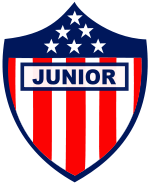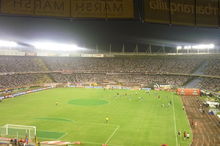- Junior de Barranquilla
-
For other uses, see C.D. Atlético Junior (Honduras).
Junior 
Full name Corporación Popular Deportiva Junior
(Junior Sport Popular Corporation)Nickname(s) Los Tiburones
(The Sharks)Founded 1924 Ground Estadio Metropolitano, Barranquilla
(Capacity: 49,612)Chairman  Antonio Char Chaljub
Antonio Char ChaljubManager  José Eugenio Cheché Hernández
José Eugenio Cheché HernándezLeague Fútbol Profesional Colombiano 2011-II 1 Home coloursAway coloursCorporación Popular Deportiva Junior,[1] known simply as Junior or by its former name Atlético Junior, is a Colombian football team based in Barranquilla. The club was founded in 1924 Known as "Los Tiburones" (The Sharks), or "El Equipo Tiburón" (The Shark Team) have won the Colombian professional football championship six times (1977, 1980, 1993, 1995, 2004, 2010). Club legends include Heleno de Freitas, Garrincha, Juan Ramón Verón, Efraín Sánchez, Carlos "El Pibe" Valderrama and Julio César Uribe.
Contents
Overview
The pride of Colombia's Caribbean coast, it had a golden age in the mid-90's, when under the conduction of Carlos "El Pibe" Valderrama, it won two of its championships, in 1993 and 1995. The team also included players such as Alexis Mendoza, Víctor Danilo Pacheco, Miguel "Niche" Guerrero, Cristian Montecinos and Ivan Rene Valenciano, which is the all-time scorer of the team with 158 goals.
Thereafter, the club owners focused on creating talent from within, and following years of up and downs, the club became once again national champions in December 2004, after scoring in the last minute and beating Atlético Nacional from Medellín in penalty kicks. The star of that season was the Argentine Omar Sebastian Perez, who earned the love and respect of the team's fans not only for his great technique and high quality of play, but for the way he blended with the rest of the team. Currently the team is one of the most important in Colombia and is led by coach Oscar Hector Quintabani. Its best current players are Giovanni Hernandez, Carlos Bacca, and Sebastián Viera.
They have participated several times in Conmebol's Copa Libertadores de América, where they ended up in 3rd place In 1994. One penalty kick away by Ronald Valderrama (Carlos "El Pibe" Valderrama 's brother) from reaching the final, they ended up losing against Vélez Sarsfield, who would then become the tournament's champion that year.
History
The history of the red, white and blue of Junior is long and proud. In the early 1920s a team named Juventus came into being at the Colegio Salesiano in the San Roque neighborhood of Barranquilla, unsurprisingly given the name made up primarily of Italian immigrants. Soon after its launch the name was changed to the Spanish Juventud, though both translate the same in English - youth. In August 1924 some of the younger members of Juventud along with other young men from San Roque created an offshoot of Juventud - Juventud Infantil.
Around 1940s (and the club's name was shortened to simply Junior) they became known as one of the country's best clubs. In 1945 the players of Junior were selected to represent Colombia at the South American Championship (now known as the Copa América), finishing a respectable fifth (though losing 7-0 to Uruguay and 9-1 to Argentina along the way). In 1949 they were again selected to represent Colombia (finishing last place) but this time their decision to play would have its consequences.
In 1948 Junior were founder members of División Mayor del Fútbol Profesional Colombiano (commonly known as the Dimayor). Their debut match as a professional outfit came at home on August 15, 1948 against Deportivo Cali, which ended in a 2-0 victory for the home side. Early the following year they were again chosen to play as the de facto Colombia national team. Because of ongoing strife between Adefutbol (the original amateur Colombian football association) and the Dimayor, Junior were threatened with expulsion from the Dimayor if they participated. They went ahead and did so and were initially given a two year suspension from the league. This was later reduced to one year and they returned to the Dimayor for the 1950 season.
This was the golden age of Colombian football commonly referred to as El Dorado (football), a time when the Dimayor was a "rebel league" unaffiliated with FIFA and many high-profile players from around the world broke their contracts and came to play. Junior were no exception, picking up players from Brazil, Argentina, Hungary and the Czech Republic in these years. But El Dorado eventually came to an end for Colombian football and for Junior and the club left the Dimayor because of financial problems after the 1953 season.
A way ahead surfaced in the mid-1960s when a rift had again developed in Colombian football, this time between Adefutbol and the newly-created Federación Colombiana de Fútbol, an organization devoted to developing professional football in the country. Adefutbol was still the official body in the eyes of FIFA and organized the national team in this period and additionally Colombian clubs did not enter the Copa Libertadores. Peace was finally made and the bulk of the amateur team that had attempted to qualify for the England World Cup signed up for Junior, who returned to the Dimayor in 1966. Junior have remained in the top level ever since.
In 1977 Junior won their first Colombian championship, finishing first place in the Apertura. They won further championships in 1980, 1993, 1995 and the 2004-II (Finalización). Junior have appeared in the Copa Libertadores nine times (reaching the semifinals in 1994), and the Copa Sudamericana and Copa CONMEBOL once each.
The red and white striped colors of Junior's shirt (and logo) are derived from the similarly colored flag of the Atlántico Department . The six stars of the logo represent the number of national championships Junior have won.[2]
In February 2011, Panamanian defender Luis Moreno is facing sanctions after he kicked an injured owl that landed on the field during a game when his Colombian club Deportivo Pereira was playing Atletico Junior. The owl, which later died of its injuries was a mascot for Atletico Junior. The owl had landed injured near the corner of the field when Moreno walked over and kicked it about three yards. Atletico Junior fans shouted "murder, murder."
Mascot
Junior's unofficial mascot owl is a barn owl. It was kicked by Panamanian defender Luis Moreno during a football match between Atlético Junior and Deportivo Pereira. It was treated by a veterinarian, but later died of shock on Tuesday March 1, 2011, at 2.57am. Moreno was allegedly upset and worried, and did not mean to kill the owl.[3] As it was about to be kicked, apparently the owl turned its head to look at Moreno.[4] Soccer officials described the unfortunate owl as "practically a symbol for the Barranquillera fan", and suspended Moreno for two games, fining him $560.[5] Some commentators suggested that kicking this owl could be the start of a slippery slope leading to children being injured.[6]
Stadium
Junior's home stadium is called Estadio Roberto Meléndez also known as Estadio Metropolitano, which also has been home to the Colombian national football team
The stadium holds up to 60,000[7] people, making it the largest in Colombia. It was built for the failed Colombian World Cup bid in 1986. It was inaugurated in 1986 with a game between Uruguay and Atletico Junior, which the Uruguayans won 2-1. The first official name of the stadium was "Estadio Metropolitano", which was changed around 1991 in order to honor a hero of Colombian football, Roberto Melendez. This was the official stadium for the national football team of Colombia, until 2006. The stadium is currently in renovation since Colombia will be hosting the 2011 FIFA U-20 World Cup
Honours
National Honours
- Fútbol Profesional Colombiano: 6
-
- 1977, 1980, 1993, 1995, 2004-II, 2010-I
International
- Reebok Cup: 1
-
- 1997
Performance in CONMEBOL competitions
- Copa Libertadores: 11 appearances
-
- Best: Semi-Finals in 1994
- 1994: Semi-Finals
- Copa Sudamericana: 1 appearance
-
- 2004: Quarter-Finals
- Copa CONMEBOL: 1 appearance
-
- 1992: Quarter-Finals
Current squad
- As of July 9, 2011
Note: Flags indicate national team as has been defined under FIFA eligibility rules. Players may hold more than one non-FIFA nationality.
No. Position Player 1 
GK Sebastián Viera 2 
DF Armando Nieves 3 
DF Anselmo de Almeida 4 
DF Sergio Otalvaro 5 
DF John Alexander Valencia 6 
DF Juan David Valencia 7 
FW Cristian Mejia 9 
FW Juan David Abisambra 10 
MF Giovanni Hernández (Captain) 11 
FW Luis Páez 12 
GK Carlos Rodríguez 13 
MF José Amaya 14 
MF Wáiner Caneda 15 
MF Luis Narváez 16 
MF Vladimir Hernández 17 
DF Brayner García No. Position Player 18 
DF Harold Macías 19 
MF Jossymar Gomez 20 
MF Sherman Cardenas 21 
GK Wanerge Delgado 22 
DF Cesar Fawcett 23 
DF Jaider Romero 24 
FW Norvey Orozco 25 
FW Victor Cortés 27 
FW Luis Carlos Ruiz 29 
DF Andres Felipe González 30 
MF Alan Navarro 32 
MF Léiner Escalante 35 
MF Francisco Rodríguez 40 
GK José Luis Chunga 70 
FW Carlos Bacca Selected former players
 Carlos Babington
Carlos Babington Edgardo Bauza
Edgardo Bauza Juan Carlos Delménico
Juan Carlos Delménico Carlos Ischia
Carlos Ischia Omar Sebastián Pérez
Omar Sebastián Pérez José Daniel Ponce
José Daniel Ponce Juan Ramón Verón
Juan Ramón Verón Dida
Dida Garrincha
Garrincha Heleno de Freitas
Heleno de Freitas Víctor Ephanor
Víctor Ephanor
 Cristián Montecinos
Cristián Montecinos Nelson Tapia
Nelson Tapia Alfredo Arango
Alfredo Arango Martín Arzuaga
Martín Arzuaga Jorge Bolaño
Jorge Bolaño
 José Kaor Doku
José Kaor Doku Rigoberto "Memuerde" García
Rigoberto "Memuerde" García Giovanni Hernandez
Giovanni Hernandez Roberto Meléndez
Roberto Meléndez Alexis Mendoza
Alexis Mendoza Víctor Danilo Pacheco
Víctor Danilo Pacheco
 Efraín "El Caimán" Sánchez
Efraín "El Caimán" Sánchez Macnelly Torres
Macnelly Torres Carlos Valderrama
Carlos Valderrama Didí Álex Valderrama
Didí Álex Valderrama Iván Valenciano
Iván Valenciano Julio César Uribe
Julio César Uribe Julio Comesaña
Julio Comesaña
References
- ^ Web oficial de DIMAYOR
- ^ http://www.albionroad.com/club-profiles/896-atletico-junior
- ^ http://www.guardian.co.uk/football/2011/mar/02/owl-colombia-luis-moreno-dies
- ^ http://www.thestar.com/article/947718--a-soccer-player-an-owl-and-an-unwise-move
- ^ http://edition.cnn.com/2011/SPORT/03/02/colombia.soccer.owl/?hpt=T2
- ^ http://blogs.telegraph.co.uk/news/peterwedderburn/100078382/an-owl-is-kicked-off-the-pitch-could-a-child-be-next/
- ^ http://www.worldstadiums.com/south_america/countries/colombia.shtml
External links
- Official Web site of Corporación Popular Deportiva Junior
- Fuerza Tiburona Supporter's Team Website
- Junior Pasion
Current (2011) teams América · Atlético Huila · Atlético Nacional · Boyacá Chicó · Cúcuta Deportivo · Deportes Tolima · Deportes Quindío · Deportivo Cali · Deportivo Pereira · Envigado · Independiente Medellín · Itagüí Ditaires · Junior · La Equidad · Millonarios · Once Caldas · Real Cartagena · Santa FeSeasons 1948 · 1949 · 1950 · 1951 · 1952 · 1953 · 1954 · 1955 · 1956 · 1957 · 1958 · 1959 · 1960 · 1961 · 1962 · 1963 · 1964 · 1965 · 1966 · 1967 · 1968 · 1969 · 1970 · 1971 · 1972 · 1973 · 1974 · 1975 · 1976 · 1977 · 1978 · 1979 · 1980 · 1981 · 1982 · 1983 · 1984 · 1985 · 1986 · 1987 · 1988 · 1989 · 1990 · 1991 · 1992 · 1993 · 1994 · 1995 · 1995–96 · 1996–97 · 1998 · 1999 · 2000 · 2001 · 2002 · 2003 · 2004 · 2005 · 2006 · 2007 · 2008 · 2009 · 2010 · 2011Early competitions Campeonato Nacional · Copa Centenario Batalla de Boyacá2011 Copa Santander Libertadores de América Champion Runner-up Eliminated in the Semifinals Eliminated in the Quarterfinals Eliminated in the Round of 16 Eliminated in the Second Stage Argentinos Juniors · Caracas · Colo-Colo · Deportes Tolima · Deportivo Táchira · Emelec · Godoy Cruz · Guaraní · Independiente · Jorge Wilstermann · León de Huánuco · Nacional · Oriente Petrolero · San Luis · Unión Española · Universidad San MartínEliminated in the First Stage Categories:- Atlético Junior
- Colombian football clubs
- Association football clubs established in 1924
Wikimedia Foundation. 2010.

